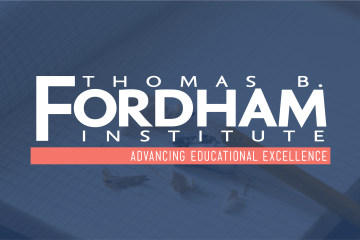It’s that time of year again when we at Fordham are forced to ask ourselves, “What were they thinking?” The “they” in question is you, our readers and subscribers. And we’re asking the question not to take issue with your level of discernment (as a loyal Gadfly reader, your good taste is a given!), but because we are genuinely interested in what subjects interested you this past year.
We are happy to know which of our opinion pieces and short reviews caught readers’ attention over the last twelve jam-packed months, although the “why” is always the most valuable question.
Here are the top five most-read pieces published on the Ohio Gadfly Daily blog in 2020—excluding some of our perennial hits like “Bless the tests” and “My experience with AP U.S. History” published in previous years and remaining popular—along with our best guess as to the reason they resonated with you.
5. “The impact of coronavirus on Ohio’s private schools” (Jessica Poiner, 6/4/20).
Four out of five of our most-read pieces this year were related to the coronavirus pandemic, which makes sense, given that it dominated every other aspect of our lives. As the 2019–20 school year limped to a close and the economic effects of pandemic-mitigation shutdowns were starting to be felt, Jessica Poiner looked at the possible implications for private schools. Tuition collection and charitable support were both expected to take a hit, with potential ripple effects into the public school sector as families faced with financial challenges could well be forced to move their children from a private to a district or charter option. In a state with a widespread private school community and popular voucher programs, this discussion clearly was of interest to readers.
Honorable mention: “What does the federal stimulus package mean for Ohio schools?” (Jessica Poiner, 4/7/20). Another prescient piece, almost tied for readership with our official number five entrant, this looked at Ohio’s options for using testing waivers and CARES Act funding to best serve students.
4. “State testing, report cards, and coronavirus” (Aaron Churchill, 3/19/20)
Readers looking for answers to difficult questions about state testing and report cards due to uncertain times ahead gravitated to this blog. On March 12, 2020, Governor Mike DeWine announced that all Ohio schools would close for three weeks in the face of the oncoming Covid-19 wave. Aaron Churchill shared the governor’s optimism at the time that in-person school could potentially resume before the scheduled end of the 2019–20 school year. Aaron posited in this piece that a modicum of normalcy could be retained by having students sit for state tests at some point before the year ended, provided improving health conditions. Needless to say, that did not come to pass, as the crisis has persisted for month after agonizing month. Here’s hoping the optimism remains for more normalcy and collection of vital student achievement data in 2021.
3. “Hard lessons about SEL implementation” (Aaron Churchill, 2/24/20)
The only non-Covid piece in our top five this year was this short review (a staple of Fordham’s analysis and commentary work for many years) of a RAND Corporation study looking at implementation of a social-emotional learning (SEL) program at a large school district in Mississippi. The downbeat findings—that no significant differences in SEL outcomes, school climate, attendance, suspensions, or test scores were observed after multiple years of implementation—coupled with national interest in SEL likely drove readers to this piece. Whether readers were looking to validate their perspectives or to pick a fight with the evaluation is unknown.
2. “Dayton Public Schools keeps missing the bus on student transportation” (Jessica Poiner, 7/1/20)
No such national interest can be attributed to this piece. Honestly, it is surprising that anyone outside of the city of Dayton would have an interest in the ongoing struggles the district has had with transporting its own students, as well as resident students attending private and charter schools. But readers came in droves to this look at Dayton’s years-long saga, including three different schemes in the preceding twelve months. The latest plan this summer, ultimately scuttled by the pandemic, was rolled out with minimal and conflicting information mere days before the scheduled start of the school year, leaving charter school leaders and their families with more questions than answers. Perhaps transportation struggles are so widespread among families utilizing school choice that this localized fiasco struck a deeper nerve than Jessica expected.
1. “Will more Ohio parents continue homeschooling after the Covid-19 crisis?” (Aaron Churchill, 3/27/20)
Our most-read blog of the year hails from a few weeks into the pandemic, when families were reeling from school closures and they, along with policymakers and the education establishment, were realizing that three weeks would not constitute the end of the upheaval. It is prescient in that Aaron was quick to equate the spring’s “remote learning” effort to old-fashioned homeschooling, a fact which had perhaps not come into general awareness yet. But as those final months of the 2019–20 school year wore on, the onus of educating millions of students seemed to shift from schools and teachers to parents and “pods” for the longer term. Aaron laid out the steps required for any Ohio parent to utilize homeschooling—formally taking on the compulsory education of their children from the “education system.” “Out of necessity,” he wrote, “millions of Ohio parents are experiencing first-hand what homeschooling would be like.” Many, he concluded, will likely “come to a deeper appreciation of the hard work their local schools do to serve children. But some might just find themselves attracted to a form of schooling they would’ve never otherwise considered.” Readers continued to find and visit this piece as spring turned to summer, and summer turned to fall. When the pandemic disruption to education is over—February? March? June?—perhaps we will finally see just how predictive it was.
* * * * *
There you have it: The blogs and reviews that you, our audience, read the most during the last twelve months. In case you didn’t know, we also had a robust research slate this year that complements our blogging. Here’s hoping for a less turbulent, more “normal” (for lack of a better word) year in 2021. We hope you’ll stay with us for more analysis, reviews, and commentary on the issues impacting Ohio schools.




